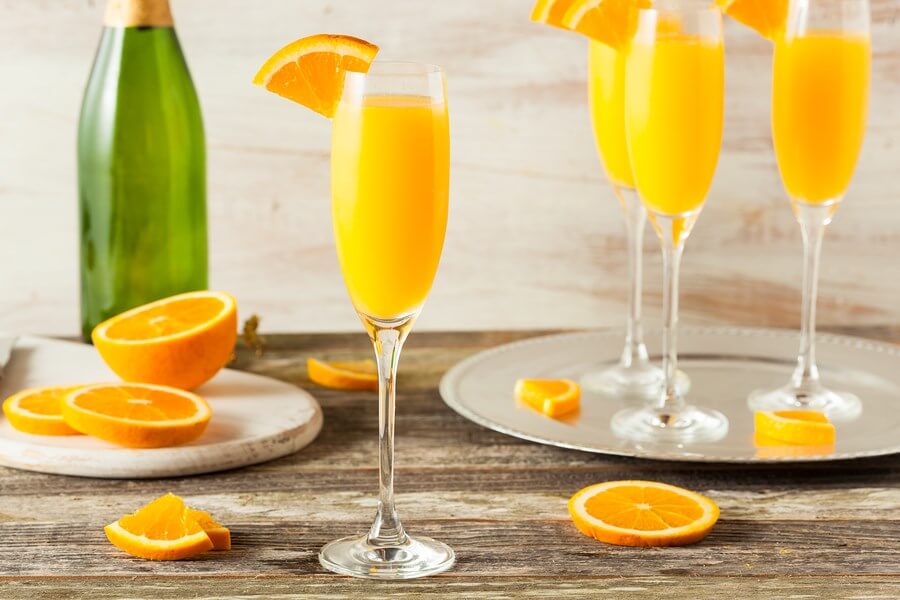In North America, the one thing that sets brunch apart from lunch, or breakfast, is brunch mimosas.

Share this article
Brunch is the ideal meal, open to both breakfast and lunch foods, usually eaten in the late morning to early afternoon. In North America, the one thing that sets brunch apart from lunch, or breakfast, is brunch mimosas. The most popular drink for brunch is the Mimosa. A basic Mimosa is made up of equal parts of champagne and orange juice with a splash of little triple sec, and served in a champagne flute. Mimosas originally came from Europe, France and Great Britain to be exact, but it quickly became the official brunch beverage in the United States and Canada. Light, refreshing, and equally delicious, the Mimosa has become a North American brunch staple; as important as the food itself.
History:
The Mimosa was originally named “Champagne-orange” in France, but later, in 1961, the British royal family dubbed the drink, the mimosa. Yes, the British royal Family enjoyed drinking Mimosas. However, they didn’t drink them brunch, but before dinner.
Modern Brunch Mimosas:
Today, mimosas are one of the most beloved cocktails, especially with brunch. It is incredibly popular in part due to women. Women between the ages of 21-50+ are enjoying brunch mimosas at an all time high. The cocktail looks very elegant, yet is simple to make perfectly; it’s light, refreshing, and fruity. If you want to cheat on your diet, you can think of the orange juice as a serving of fruit for the day! It has 111 calories per serving, far less than most cocktails which contain more alcohol and sugars. It is also easy to digest, and it’s lightness leaves you room to enjoy your meal, without feeling heavy. Forget brunch, it’s the perfect simple summertime cocktail, period. Cyndi Lauper said “Girls just want to have fun,” with Mimosas, they have it.
Recipes For Brunch Mimosas:
There are many varieties of Mimosa that include simple syrup, and different varieties of alcohols and fruit juices. Some swear by the grapefruit Mimosa. With a beautiful pink color, and an even more acidic punch. However, for older women on medication who cannot eat grapefruit this variation might not be ideal.
If you want to take this experience to the next level, try to impress them with:
Women between the ages of 21-50+ are enjoying brunch mimosas at an all time high. The cocktail looks very elegant, yet is simple to make perfectly; it’s light, refreshing, and fruity.
The Pineapple Mimosa:
- Pineapple Juice
- Sparkling Prosecco (Or Champagne)
- Citrus (Orange or Lemon juice)
Mix equal parts pineapple juice and sparkling Prosecco. If you would like, add a little orange juice or a few drops of lemon juice to give it that acidic kick. (Triple Sec is optional) This is a unique twist on the classic that keeps it simple, but delivers a completely different experience.
If you mix equal parts pineapple juice and champagne, the result a cocktail named Soleil (French word for “sun”).
For a more alcoholic beverage, use pineapple vodka instead of pineapple juice.
Mimosas don’t always need to be made with the most valuable sparkling wines! But they do improve the experience!
Pretty In Pink Mimosa:
- Fresh Pomegranate Juice.
- Sparkling wine (Or Champagne)
- Pomegranate seeds,
Squeeze some pomegranate juice (fresh is best) and mix it with sparkling wine/champagne in a wine glass. Serve it in a classic martini glass or wine flute and add several pomegranate seeds to garnish garnish.
For a more alcoholic Mimosa, use pomegranate liquor.
Conclusion
With mimosas, the classic is amazing, but experimentation is recommended! Try different types and adjust the ingredients according to your own taste. One thing is sure, there is no better cocktail to drink during brunch, or any other time you want to celebrate!